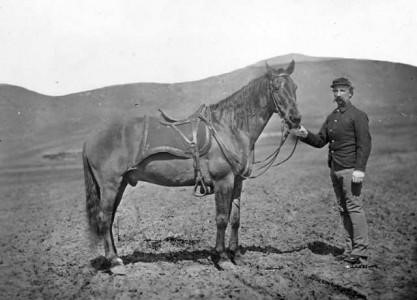Comanche
 A mustang purchased by the U.S. Calvary in 1858 was wounded in the hindquarters by an arrow during a battle against Native Americans. Despite this wound, he continued to carry his rider through the battle. To honor this bravery he showed during the battle against the Comanche, they named him such. He fought in the Battle of Little Bighorn and was found in a ravine severely wounded two days after the defeat of General George Custer and his troops. Comanche was carefully transported to Fort Lincoln in North Dakota where he spent an entire year being nursed back to health. After Comanche fully recovered, he never had to see another battle. He was officially retired and orders were decreed that he would not be ridden or put to work again and would live the rest of his days in peace. It was during this retirement in which Comanche became a symbol of Custer’s memory and became a celebrity as he took part in several parades and ceremonies. Comanche was famous for being the sole survivor of Custer’s Last Stand (several other horses had been taken hostage by Native Americans) and he is now on display at the University of Kansas Museum of Natural History. He is one of only two American battle horses that received a military funeral.
A mustang purchased by the U.S. Calvary in 1858 was wounded in the hindquarters by an arrow during a battle against Native Americans. Despite this wound, he continued to carry his rider through the battle. To honor this bravery he showed during the battle against the Comanche, they named him such. He fought in the Battle of Little Bighorn and was found in a ravine severely wounded two days after the defeat of General George Custer and his troops. Comanche was carefully transported to Fort Lincoln in North Dakota where he spent an entire year being nursed back to health. After Comanche fully recovered, he never had to see another battle. He was officially retired and orders were decreed that he would not be ridden or put to work again and would live the rest of his days in peace. It was during this retirement in which Comanche became a symbol of Custer’s memory and became a celebrity as he took part in several parades and ceremonies. Comanche was famous for being the sole survivor of Custer’s Last Stand (several other horses had been taken hostage by Native Americans) and he is now on display at the University of Kansas Museum of Natural History. He is one of only two American battle horses that received a military funeral.

